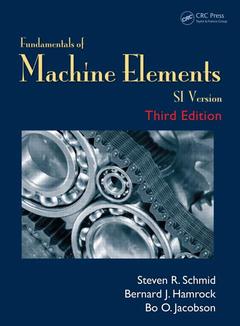Fundamentals of Machine Elements (3rd Ed.) SI Version
Auteurs : Schmid Steven R., Hamrock Bernard J., Jacobson Bo. O.

New and Improved SI Edition?Uses SI Units Exclusively in the Text
Adapting to the changing nature of the engineering profession, this third edition of Fundamentals of Machine Elements aggressively delves into the fundamentals and design of machine elements with an SI version. This latest edition includes a plethora of pedagogy, providing a greater understanding of theory and design.
Significantly Enhanced and Fully Illustrated
The material has been organized to aid students of all levels in design synthesis and analysis approaches, to provide guidance through design procedures for synthesis issues, and to expose readers to a wide variety of machine elements. Each chapter contains a quote and photograph related to the chapter as well as case studies, examples, design procedures, an abstract, list of symbols and subscripts, recommended readings, a summary of equations, and end-of-chapter problems.
What?s New in the Third Edition:
- Covers life cycle engineering
- Provides a description of the hardness and common hardness tests
- Offers an inclusion of flat groove stress concentration factors
- Adds the staircase method for determining endurance limits and includes Haigh diagrams to show the effects of mean stress
- Discusses typical surface finishes in machine elements and manufacturing processes used to produce them
- Presents a new treatment of spline, pin, and retaining ring design, and a new section on the design of shaft couplings
- Reflects the latest International Standards Organization standards
- Simplifies the geometry factors for bevel gears
- Includes a design synthesis approach for worm gears
- Expands the discussion of fasteners and welds
- Discusses the importance of the heat affected zone for weld quality
- Describes the classes of welds and their analysis methods
- Considers gas springs and wave springs
- Contains the latest standards and manufacturer?s recommendations on belt design, chains, and wire ropes
The text also expands the appendices to include a wide variety of material properties, geometry factors for fracture analysis, and new summaries of beam deflection.
Part I — Fundamentals. Introduction. Load, Stress, and Strain. Introduction to Materials and Manufacturing. Stresses and Strains. Deformation. Failure Prediction for Static Loading. Fatigue and Impact. Lubrication, Friction, andWear. Part II — Machine Elements. Columns. Stresses and Deformations in Cylinders. Shafting and Associated Parts. Hydrodynamic and Hydrostatic Bearings. Rolling-Element Bearings. General Gear Theory; Spur Gears. Helical, Bevel, and Worm Gears. Fasteners, Connections, and Power Screws. Springs. Brakes and Clutches. Flexible Machine Elements. Appendices. Index.
Steven R. Schmid received his B.S. in mechanical engineering from the Illinois Institute of Technology in 1986. He earned his master’s degree from Northwestern University in 1989 and his Ph.D. in 1993, both in mechanical engineering. In 1993 he joined the faculty at the University of Notre Dame, where he is a professor of aerospace and mechanical engineering, teaching and conducting research in design and manufacturing. Dr. Schmid holds professional engineering (P.E.) and certified manufacturing engineer (C.Mfg.E.) licenses. He was awarded the ASME Foundation Swanson Fellowship in 2012, and is a Fellow of the American Society of Mechanical Engineers.
Bernard J. Hamrock Bo O. Jacobson
Date de parution : 07-2014
21.9x27.6 cm
Thèmes de Fundamentals of Machine Elements :
Mots-clés :
Stress Concentration Factor; Bevel Gears; Load; Safety Factor; Stresses And Strains; Load Carrying Capacity; Failure Prediction For Static Loading; Bending Stress; Machine Elements; Pitch Diameter; Manufacturing; Helical Gears; Deformation; Contact Ratio; Static Loading; Rolling Element Bearings; Fatigue And Impact; Spur Gears; Columns; Pressure Angle; Stresses And Deformations In Cylinders; Transverse Shear; Diametral Pitch; Gear Teeth; Load Distribution Factor; Journal Bearings; Fatigue Stress Concentration Factor; Minimum Film Thickness; Free Body Diagram; Ellipticity Parameter; Fluid Film Lubrication; Machine Element; Face Width; Spring Rate; Worm Gear



